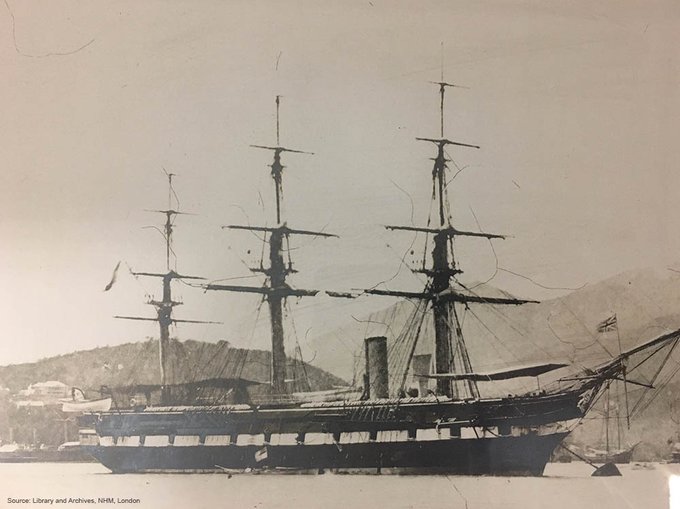SpecimensのTwitterイラスト検索結果。 763 件中 28ページ目
Kate Furbish was born this month in 1834 and dedicated herself to compiling "Flora of Maine", donated to @BowdoinCollege. She described Pedicularis furbishiae and Aster cordifolius var furbishiae, and her 4k specimens were passed from @NewEngBotanical to Gray @HarvardHerbaria.
Happy #FossilFriday everyone! Check out our 3D model of a grizzly bear now on #sketchfab and the research being done by @AlexisMychajliw on @labreatarpits specimens! https://t.co/z3GUWigyee #tarpitsoftheworld #research #fossils #paleontology #bears
Following the #MuseumsUnlocked photography theme today:
A crucial piece of equipment in our collections - the HerbScan machine for imaging pressed botanical specimens without turning them upside down.
We can then share the high quality photos for science, art and museum lovers!
Some of plant specimens collected by Ynes Mexia can be found digitized at the NYBG Steere Herbarium. https://t.co/KVviIXSnnG
Spending the morning trying to draw things from a dream, and remembering I never posted these excellent specimens sleep-me came up with.
@splatonoodles hello, thank you for hosting this! i’m a hobbyist so my goals are a bit silly, mainly just trying to be more social and have more eyes looking at my doodles. a lot of what i do is nsfw but here’s a couple of sfw specimens:
Data, samples and specimens collected during the HMS Challenger voyage from nearly 150 years ago can be used to measure the effects of #ClimateMW change today. The published reports from the expedition are freely available via @BioDivLibrary https://t.co/5nqd4cBYwE #MuseumWeek
@ni075 @CambrianShe In some specimens, you’re also able to see the transition between the annulations of the head and frontal appendage and the smooth cuticle of the trunk.
I've been updating Wikipedia species pages with details of important & type specimens @World_Museum. Its nice when I find info about the specimens is already there, such as the types of the Himalayan Quail which were painted by both Edward Lear, for the description, & John Gould
#mermay day 9: blanket octopus!
this cephalopod is most known for the incredibly long webbing connecting its tentacles, a trait only found in female specimens!
males are only about the size of a walnut, while females have been shown to get up to 6 feet in length!
Fernandez Dumont et al. (2020) describe new specimens of the notosuchian Araripesuchus buitreraensis, from Argentinian Patagonia, revealing new morphological information. https://t.co/zJWyW5sCNt
Mrs. Hussey collected mushroom specimens and made beautiful illustrations like this one of a poisonous, carrion-scented mushroom. She published 163 such plates in "Illustrations of British Mycology".
"Devil's Mushroom/Boletus satanas"
Anna Maria Hussey
1847
Watercolor on Paper
Two posts for the last day of the fabulous @dominikhhh‘s special session for @OpenGLAM #enthis. The first shows three plates of #Chelsea #porcelain c. 1755 featuring botanical specimens culled from London‘s Chelsea Physic Garden, expanded under Hans Sloane in 1713
John Reeves was born #OTD 1774. He was the East India Company’s Inspector of Teas in China for 19 years (1812-1831). He collected plant & animal specimens & comissioned watercolours of many species by Chinese artists. The Reeves pheasant and Reeves muntjac are named after him.
#PlantHumanities, #plant #VisualCultures: #botanical #drawings as proxy #specimens, used by #herbarium #botanists in plant identification. Shown here: 1 &2 by #Vishnupersaud, 3 & 4 by William #Burchell, early #C19. #art & #science in counterpoise @RoyalHolloway @Kew_LAA
Seaweed collecting was a popular Victorian pastime, with enthusiasts including Queen Victoria and George Eliot. ‘Ocean flowers and their teachings’ (1846) contains pressed seaweed specimens and was perfect for budding phycologists!
#RareBooks #Phycology
Louise von Panhuys (1763-1844): Germanic botanical artist and landscape painter. She went to Surinam and created volumes of botanical specimens; mainly, she painted watercolours of plant specimens, with attention to scientific accuracy.
On this day in 1794, German botanist and explorer Carl Friedrich Philipp von Martius was born. Martius focused most of his work on Brazil - collecting thousands of specimens from the region. https://t.co/7kluizARa8
●otice of the start of the sale of artworks.●
Five specimens are now on sale at TAGBOAT!
They look like insect specimens in a specimen box.
This is a great opportunity to add it to your collection!
https://t.co/T9rtR5dchQ
The photo is "Specimen No. 25".
Watercolour, from my book. I adored visiting London's @NHM_London for all the specimens, as it gives great fodder for practise.





























































